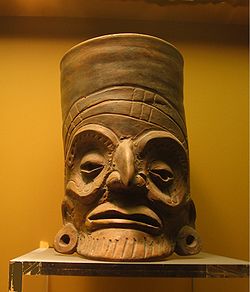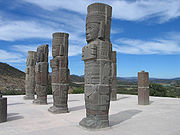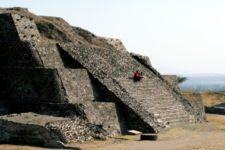
Toltec
Encyclopedia

Mesoamerica
Mesoamerica is a region and culture area in the Americas, extending approximately from central Mexico to Belize, Guatemala, El Salvador, Honduras, Nicaragua, and Costa Rica, within which a number of pre-Columbian societies flourished before the Spanish colonization of the Americas in the 15th and...
n culture that dominated a state centered in Tula, Hidalgo
Tula, Hidalgo
Tula, formally, Tula de Allende, is a town and one of the 84 municipalities of Hidalgo, in central-eastern Mexico. The municipality covers an area of 305.8 km² , and as of 2005, the municipality had a total population of 93,296, with 28,432 in the town...
in the early post-classic period of Mesoamerican chronology
Mesoamerican chronology
Mesoamerican chronology divides the history of pre-Columbian Mesoamerica into several periods: the Paleo-Indian , the Archaic , the Preclassic , the Classic , and the Postclassic...
(ca 800-1000 CE). The later Aztec
Aztec
The Aztec people were certain ethnic groups of central Mexico, particularly those groups who spoke the Nahuatl language and who dominated large parts of Mesoamerica in the 14th, 15th and 16th centuries, a period referred to as the late post-classic period in Mesoamerican chronology.Aztec is the...
culture saw the Toltecs as their intellectual and cultural predecessors and described Toltec culture emanating from Tollan (Nahuatl for Tula) as the epitome of civilization, indeed in the Nahuatl language the word "Toltec" came to take on the meaning "artisan". The Aztec oral and pictographic tradition also described the history of the Toltec empire giving lists of rulers and their exploits. Among modern scholars it is a matter of debate whether the Aztec narratives of Toltec history should be given credence as descriptions of actual historical events. While all scholars acknowledge that there is a large mythological part of the narrative some maintain that by using a critical comparative method some level of historicity can be salvaged from the sources, whereas others maintain that continued analysis of the narratives as sources of actual history is futile and hinders access to actual knowledge of the culture of Tula, Hidalgo. Other controversy relating to the Toltecs include how best to understand reasons behind the perceived similarities in architecture and iconography between the archaeological site of Tula and the Maya site of Chichén Itzá
Chichen Itza
Chichen Itza is a large pre-Columbian archaeological site built by the Maya civilization located in the northern center of the Yucatán Peninsula, in the Municipality of Tinúm, Yucatán state, present-day Mexico....
- as of yet no consensus has emerged about the degree or direction of influence between the two sites.
Aztec view

Florentine Codex
The Florentine Codex is the common name given to a 16th century ethnographic research project in Mesoamerica by Franciscan friar Bernardino de Sahagún. Bernardino originally titled it: La Historia General de las Cosas de Nueva Espana...
describes the Aztec view of the Toltecs like this:
"The Tolteca were wise. Their works were all good, all perfect, all wonderful, all marvelous... They invented the art of medicine... And these Tolteca were very wise; they were thinkers, for they originated the year count... These Tolteca were righteous. They were not deceivers. Their words [were] clear words . . . They were tall; they were larger [than the people today]... They were very devout... They were rich. (Sahagún, 1950–1982: book 10, 165–170)"
Archaeology

Richard Diehl
Richard A. Diehl is an American archaeologist, anthropologist and academic, noted as a scholar of pre-Columbian Mesoamerican cultures...
, argue for the existence of a Toltec archaeological horizon characterized by certain stylistic traits associated with Tula, Hidalgo and extending to other cultures and polities in Mesoamerica. Traits associated with this horizon are: The Mixteca-Puebla style of iconography, Tohil plumbate ceramic ware and Silho or X-Fine Orange Ware ceramics. The presence of stylistic traits associated with Tula in Chichén Itzá
Chichen Itza
Chichen Itza is a large pre-Columbian archaeological site built by the Maya civilization located in the northern center of the Yucatán Peninsula, in the Municipality of Tinúm, Yucatán state, present-day Mexico....
is also taken as evidence for a Toltec horizon. Especially the nature of interaction between Tula and Chichén Itzá has been controversial with Scholars arguing for either military conquest of Chichén Itzá by Toltecs, Chichén Itzá establishing Tula as a colony or only loose connections between the two. The existence any meaning of the Mixteca-Puebla art style has also been questioned.
A contrary viewpoint is argued in a 2003 study by Michael E. Smith
Michael E. Smith
Michael Ernest Smith is an American archaeologist working primarily with Aztec and general Mesoamerican archaeology. He has written numerous scholarly articles about central Mexican archaeology as well as several books about the Aztecs, among them a widely used textbook...
and Lisa Montiel who compare the archaeological record related to Tula Hidalgo to those of the polities centered in Teotihuacan
Teotihuacan
Teotihuacan – also written Teotihuacán, with a Spanish orthographic accent on the last syllable – is an enormous archaeological site in the Basin of Mexico, just 30 miles northeast of Mexico City, containing some of the largest pyramidal structures built in the pre-Columbian Americas...
and Tenochtitlan. They conclude that relative to the influence exerted in Mesoamerica by Teotihuacan and Tenochtitlan, Tula's influence on other cultures was negligible and was probably not deserving of being defined as an empire
Empire
The term empire derives from the Latin imperium . Politically, an empire is a geographically extensive group of states and peoples united and ruled either by a monarch or an oligarchy....
. While Tula does have the urban complexity expected of an imperial capital its influence and dominance was not very far reaching. Evidence for Tula's participance in extensive trade networks has been uncovered, for example the remains of a large obsidian
Obsidian
Obsidian is a naturally occurring volcanic glass formed as an extrusive igneous rock.It is produced when felsic lava extruded from a volcano cools rapidly with minimum crystal growth...
workshop.
History of research
The debate about the nature of the Toltec culture goes back to the late 19th century. Mesoamericanist scholars such as Veitia, Manuel Orozco y Berra, Charles Etienne Brasseur de BourbourgCharles Etienne Brasseur de Bourbourg
Abbé Charles-Étienne Brasseur de Bourbourg was a noted French writer, ethnographer, historian and archaeologist...
, Francisco Clavigero all read the Aztec chronicles and believed them to be realistic historic descriptions of pan-Mesoamerican empire based at Tula, Hidalgo. This historicist view was first challenged by Daniel Garrison Brinton
Daniel Garrison Brinton
Daniel Garrison Brinton was an American archaeologist and ethnologist.-Biography:Brinton was born in Thornbury Township, Chester County, Pennsylvania. After graduating from Yale University in 1858, Brinton studied at Jefferson Medical College for two years and spent the next travelling in Europe....
who argued that the "Toltecs" as described in the Aztec sources were merely one of several Nahuatl speaking citystates in the postclassic period, and not a particularly influential one at that. He attributed the Aztec view of the Toltecs to the "tendency of the human mind to glorify the good old days", and the confounding of the place of Tollan with the myth of the struggle between Quetzalcoatl and Tezcatlipoca
Tezcatlipoca
Tezcatlipoca was a central deity in Aztec religion. One of the four sons of Ometeotl, he is associated with a wide range of concepts, including the night sky, the night winds, hurricanes, the north, the earth, obsidian, enmity, discord, rulership, divination, temptation, jaguars, sorcery, beauty,...
. Désiré Charnay
Désiré Charnay
Claude-Joseph Désiré Charnay was a French traveller and archaeologist notable both for his explorations of Mexico and Central America, and for the pioneering use of photography to document his discoveries....
, the first archaeologist to work at Tula, Hidalgo, defended the historicist views based on his impression of the Toltec capital, and was the first to note similarities in architectural styles between Tula and Chichén Itza. This led him to posit the theory that Chichén Itzá had been violently taken over by a Toltec military force under the leadership of Kukulcan. Following Charnay the term Toltec has since been associated with the influx of certain Central Mexican cultural traits into the Mayan sphere of dominance that took place in the late classic and early Postclassic periods; the Postclassic Mayan civilizations of Chichén Itzá
Chichen Itza
Chichen Itza is a large pre-Columbian archaeological site built by the Maya civilization located in the northern center of the Yucatán Peninsula, in the Municipality of Tinúm, Yucatán state, present-day Mexico....
, Mayapán
Mayapan
Mayapan , is a Pre-Columbian Maya site a couple of kilometers south of the town of Telchaquillo in Municipality of Tecoh, approximately 40 km south-east of Mérida and 100 km west of Chichen Itza; in the state of Yucatán, Mexico...
and the Guatemalan highlands have been referred to as "Toltecized" or "Mexicanized" Mayas.
The historicist school of thought persisted well in to the 20th century, represented in the works of scholars such as David Carrasco, Miguel León Portilla, Nigel Davies
Nigel Davies (historian)
Dr. Claude Nigel Byam Davies was a British anthropologist and historian who specialised in the study of the cultures of pre-Columbian America, publishing 12 academic works on the Aztec, Inca and Toltec societies...
and H. B. Nicholson
H. B. Nicholson
Henry Bigger Nicholson was a prominent scholar of the Aztecs.Nicholson died of a heart attack on March 2, 2007.-Works:*Two Aztec Wood Idols: Iconographic and Chronologic Analysis...
which all held the Toltecs to have been an actual ethnic group. This school of thought connected the "Toltecs" to the archaeological site of Tula
Tula, Hidalgo
Tula, formally, Tula de Allende, is a town and one of the 84 municipalities of Hidalgo, in central-eastern Mexico. The municipality covers an area of 305.8 km² , and as of 2005, the municipality had a total population of 93,296, with 28,432 in the town...
, which was taken to be the Tollan
Tollan
Tollan, Tolan, or Tolán is a name used for the capital cities of two empires of Pre-Columbian Mesoamerica; first for Teotihuacan, and later for the Toltec capital, Tula-Hidalgo, both in Mexico...
of Aztec myth. This tradition assumes that much of central Mexico
Mexico
The United Mexican States , commonly known as Mexico , is a federal constitutional republic in North America. It is bordered on the north by the United States; on the south and west by the Pacific Ocean; on the southeast by Guatemala, Belize, and the Caribbean Sea; and on the east by the Gulf of...
was dominated by a "Toltec empire" between the 10th and 12th century CE. The Aztecs referred to several Mexican citystates as Tollan, "Place of Reeds", such as "Tollan Cholollan
Cholula
Cholula is a city and district located in the center west of the state of Puebla, next to the city of Puebla de Zaragoza, in central Mexico. Cholula is best known for its Great Pyramid, with the Nuestra Señora de los Remedios sanctuary on top and its numerous churches...
". Historian Enrique Florescano has argued that the "original" Tollan was probably Teotihuacán
Teotihuacán
Teotihuacan – also written Teotihuacán, with a Spanish orthographic accent on the last syllable – is an enormous archaeological site in the Basin of Mexico, just 30 miles northeast of Mexico City, containing some of the largest pyramidal structures built in the pre-Columbian Americas...
, and that the Mayan sources refer to Chichén Itzá
Chichen Itza
Chichen Itza is a large pre-Columbian archaeological site built by the Maya civilization located in the northern center of the Yucatán Peninsula, in the Municipality of Tinúm, Yucatán state, present-day Mexico....
when talking about the mythical place Zuyua (Tollan).
Many historicists such as H. B. Nicholson (2001 (1957)) and Nigel Davies (1977) were fully aware that the Aztec chronicles were a mixture of mythical and historical accounts, this led them to try to separate the two by applying a comparative approach to the varying Aztec narratives. For example they seek to discern between the deity Quetzalcoatl
Quetzalcoatl
Quetzalcoatl is a Mesoamerican deity whose name comes from the Nahuatl language and has the meaning of "feathered serpent". The worship of a feathered serpent deity is first documented in Teotihuacan in the first century BCE or first century CE...
and a Toltec ruler often referred to as Topiltzin Ce Acatl Quetzalcoatl.
Toltecs as myth
In recent decades the historicist position has fallen out of favor for a more critical and interpretive approach to the historicity of the Aztec mythical accounts based on the original approach of Brinton. This approach applies a different understanding of the word Toltec to the interpretation of the Aztec sources, interpreting it as largely a mythical and philosophical construct by either the Aztecs or Mesoamericans generally that served to symbolize the might and sophistication of several different civilizations during the Mesoamerican Postclassic periodMesoamerican chronology
Mesoamerican chronology divides the history of pre-Columbian Mesoamerica into several periods: the Paleo-Indian , the Archaic , the Preclassic , the Classic , and the Postclassic...
.
Scholars such as Michel Graulich (2002) and Susan D. Gillespie
Susan D. Gillespie
Susan D. Gillespie is an American academic anthropologist and archaeologist, noted for her contributions to archaeological and ethnohistorical research on pre-Columbian Mesoamerican cultures, in particular the Aztec, Maya and Olmec...
(1989) maintain that the difficulties in salvaging actual historic data from the Aztec accounts of Toltec history are too great to overcome. For example, there is not one supposed Toltec ruler identified with Quetzalcoatl, but two: the first ruler and founder of the Toltec dynasty, and the last ruler, who saw the end of the Toltec glory and was forced into humiliation and exile. The first is described as a valiant triumphant warrior, but the last as a feeble and self-doubting old man. This causes Graulich and Gillespie to suggest that the general Aztec cyclical view of time, where events repeated themselves at the end and beginning of cycles or eras was being inscribed into the historical record by the Aztecs, making it futile to attempt to distinguish between a historical Topiltzin Ce Acatl and a Quetzalcoatl
Quetzalcoatl
Quetzalcoatl is a Mesoamerican deity whose name comes from the Nahuatl language and has the meaning of "feathered serpent". The worship of a feathered serpent deity is first documented in Teotihuacan in the first century BCE or first century CE...
deity. Graulich argues that the Toltec era is best considered the fourth of the Five Aztec mythical "Suns" or ages, the one immediately preceding the fifth sun of the Aztec people, presided over by Quetzalcoatl. This causes Graulich to consider that the only possibly historical data in the Aztec chronicles are the names of some rulers and possibly some of the conquests ascribed to them.
Further more among the Nahuan peoples the word "Tolteca" was synonymous with artist, artisan or wise man, and "toltecayotl" "Toltecness" meant art, culture and civilization and urbanism—and was seen as the opposite of "Chichimeca
Chichimeca
Chichimeca was the name that the Nahua peoples of Mexico generically applied to a wide range of semi-nomadic peoples who inhabited the north of modern-day Mexico and southwestern United States, and carried the same sense as the European term "barbarian"...
yotl" "Chichimecness", which symbolized the savage, nomadic state of peoples who had not yet become urbanized. This interpretation argues that any large urban center in Mesoamerica could be referred to as "Tollan" and its inhabitants as Toltecs—and that it was common practice among ruling lineages in Postclassic Mesoamerica to strengthen claims to power by claiming Toltec ancestry. Mesoamerican migration accounts often state that Tollan was ruled by Quetzalcoatl
Quetzalcoatl
Quetzalcoatl is a Mesoamerican deity whose name comes from the Nahuatl language and has the meaning of "feathered serpent". The worship of a feathered serpent deity is first documented in Teotihuacan in the first century BCE or first century CE...
(or Kukulkan
Kukulkan
Kukulkan is the name of a Maya snake deity that also serves to designate historical persons. The depiction of the feathered serpent deity is present in other cultures of Mesoamerica. Kukulkan is closely related to the god Q'uq'umatz of the K'iche' Maya and to Quetzalcoatl of the Aztecs...
in Yucatec and Q'uq'umatz in K'iche'
K'iche' language
The K’iche’ language is a part of the Mayan language family. It is spoken by many K'iche' people in the central highlands of Guatemala. With close to a million speakers , it is the second-most widely spoken language in the country after Spanish...
), a godlike mythical figure who was later sent into exile from Tollan and went on to found a new city elsewhere in Mesoamerica. Claims of Toltec ancestry and a ruling dynasty founded by Quetzalcoatl have been made by such diverse civilizations as the Aztec
Aztec
The Aztec people were certain ethnic groups of central Mexico, particularly those groups who spoke the Nahuatl language and who dominated large parts of Mesoamerica in the 14th, 15th and 16th centuries, a period referred to as the late post-classic period in Mesoamerican chronology.Aztec is the...
, the Quiché and the Itza'
Itza
The Itza are a Guatemalan ethnic group of Maya affiliation speaking the Itza' language. They inhabit the Petén department of Guatemala in and around the city of Flores on the Lake Petén Itzá.- Numbers of ethnic group members and Itza speakers :...
Mayas.
While the skeptical school of thought does not deny that cultural traits of a seemingly central Mexican origin have diffused into a larger area of Mesoamerica, it tends to ascribe this to the dominance of Teotihuacán in the Classic period and the general diffusion of cultural traits within the region. Recent scholarship, then, does not see Tula, Hidalgo as the capital of the Toltecs of the Aztec accounts, but rather takes "Toltec" to mean simply an inhabitant of Tula during its apogee. Separating the term "Toltec" from those of the Aztec accounts, it attempts to find archaeological clues to the ethnicity, history and social organization of the inhabitants of Tula.

